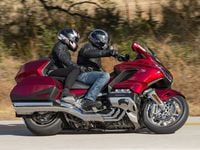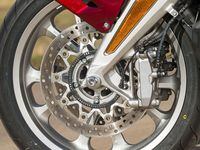Given the passenger seat on most of the bikes I bring home, it’s usually pretty hard to convince my significant other to go for an all-day ride, especially if it’s cold out. After one look at the lounge-like chair on the new Gold Wing Tour, however, my wife Loren was actually excited for our test ride in chilly central Texas, and she found the controls for her heated seat before I’d even fired up the King Wing’s flat-six. For more than four decades now the Gold Wing has been one of the most comfortable places to spend time on two wheels, and for 2018 it gets even better.It starts, as you might expect, with where you park your butt. The pleated and bolstered captain’s chairs of the previous generation are gone, but after riding a 2017 model and a 2018 back to back we didn’t miss them, and we certainly don’t miss them looking like grandpa’s recliner. I prefer the softer foam of the new seat, and the way the narrower forward portion makes it easier to put your feet down at stops. There’s also a revised riding position that’s a little less awkwardly upright. Loren, petite as she is, thought the previous-gen seat was just too big, voting the 2018 setup best because it left less of a gap between me and her. She voiced the same sentiment when we rode BMW’s K1600GTL and R1200RT, preferring the more compact layout of the RT since it made her feel more secure.
Improvements continue with the aerodynamics and the ease with which you can adjust airflow on the new bike. You might think that the 2018 Wing's smaller windscreen and narrower fairing wouldn't block the wind as well as before, but you'd be wrong. Through the miracle of wind-tunnel testing the new bike actually offers smoother currents around the rider and passenger. Plus, there's now a rocker switch that lets you dial in the windscreen height without having to unlock latches and physically push and pull on the shield like you had to in years past. That's a big convenience. Loren and I noticed our Shoei Neotecs getting batted around less on the new model no matter what position the screen was in, and I liked the fact that at full extension you actually look through the windscreen on the '18, not across the top of it.
Another difference between the two models is the ride quality. Big bikes tend to soak up bumps pretty well anyway, but the Honda really feels like it’s floating down the road. The vigorous up-and-down motion of the tie-rod ends on the new double-wishbone front end, besides bouncing enough to be distracting, make it clear the suspension is very busy even if doesn’t feel that way at the grips. And while one rider I spoke to thought the new front-end setup felt vague, I was impressed with how light and precise the steering was and surprised by how far over you could bank the big bike before hard parts began to drag. It’s not as sporty as BMW’s K1600GTL and the electronically adjustable suspension (rear preload only) doesn’t hold a candle to the German D-ESA semi-active suspension, but the Gold Wing is still an agile land yacht that’ll eat up corners.
You want power as smooth as a kitten’s ear? Get yourself a six-cylinder. Thrust from the completely reworked 1,833cc flat-six is indistinguishable from years past—the Wing still surges forward on a never-ending flow of smooth, strong torque. Acceleration in the first three gears will tickle your guts and make your passenger giggle, but roll-on performance in the upper ratios is fairly relaxed. We hopped on a seven-speed DCT-equipped bike for a short stint and the automatic-shifting technology is a great fit for the big tourer, but prepare to have your friend’s clown you for riding the world’s biggest scooter. Loren liked how seamlessly the transmission upshifted, but we were both frustrated by the inconsistent timing and occasionally rough action of downshifts. On the manual-trans bike—now a conventional six-speed—downshifts are smoothed by a new slipper clutch. Both models have a nifty reverse mode to help you maneuver in parking lots, and the DCT even gets a pushbutton “walking speed” forward feature. Dorky as you may look while dog-paddling the bike, the walking modes are a pretty handy thing to have when your all-in weight is well over 1,000 pounds.
The brakes (now radially mounted) are noticeably stronger and more precise, and the throttle response (now ride-by-wire) is more refined as well as adjustable via four ride modes.The whole dash and control interface has been redesigned (thank God!), eliminating the 700 or so buttons by combining functions into a fairly intuitive menu system displayed on the new 7-inch TFT dash. The minor improvements in comfort and refinement are all well and good, but it’s that new sleek dash that makes the biggest difference in the bike’s overall sense of modernity.
Honda's mandate to slim down and streamline the various Gold Wing models has resulted in lighter (by a claimed 70-or-so pounds, depending on the trim level) machines, but it means there's one less gallon of gas under the seat and a 40-liter reduction in luggage space. As far as I can tell, those are really the only two downsides to the new bike. There's not much you can do about the smaller side cases except pack lighter, but Honda claims the new engine is 20 percent more efficient and that overall range is the same as before (about 250 miles). During our relaxed-pace ride, however, we averaged 38.4 mpg, only 2 mpg up on the last Gold Wing we tested. Woops. With those numbers you're good for about 200 miles until empty.
Compared to previous base G-Wing the new Gold Wing Tour is $2,000 more at $26,700, but you're getting a lot of improvements for the money. Even so, if you take a look at this price comparison of luxury touring models, the Tour is priced higher than the lighter, more sophisticated, and more powerful BMW K1600GTL. Once you're this deep into this narrow niche of motorcycling, however, there's likely a lot more to your choice in bikes than just the specifications and a few thousand dollars. So if a weekend getaway is what you're after—or even if you want to cruise across the country—you can't go wrong with the new Gold Wing, especially if you want your significant other to join you for the ride.

























/cloudfront-us-east-1.images.arcpublishing.com/octane/VZZXJQ6U3FESFPZCBVXKFSUG4A.jpg)
/cloudfront-us-east-1.images.arcpublishing.com/octane/QCZEPHQAMRHZPLHTDJBIJVWL3M.jpg)
/cloudfront-us-east-1.images.arcpublishing.com/octane/HXOUJXQWA5HBHGRO3EMJIGFMVI.jpg)

/cloudfront-us-east-1.images.arcpublishing.com/octane/3TIWWRV4JBBOLDVGRYECVVTA7Y.jpg)
/cloudfront-us-east-1.images.arcpublishing.com/octane/KIX5O23D5NAIBGFXBN3327DKZU.jpg)
/cloudfront-us-east-1.images.arcpublishing.com/octane/7GJYDUIPXRGMTMQKN6ONYOLBOU.jpg)
/cloudfront-us-east-1.images.arcpublishing.com/octane/MUQLOVLL2ZDGFH25ILABNBXKTI.jpg)
/cloudfront-us-east-1.images.arcpublishing.com/octane/TNOU5DNE2BC57MFPMGN2EIDXAM.jpg)
/cloudfront-us-east-1.images.arcpublishing.com/octane/GTCXACQGJ5HAPDTGWUQKDEH44E.jpg)
/cloudfront-us-east-1.images.arcpublishing.com/octane/S35YGSEMEZB4BLTDJTSZPF4GLA.jpg)
/cloudfront-us-east-1.images.arcpublishing.com/octane/5UOT6HPX2JFMRJAX6EH45AR4MQ.jpg)
/cloudfront-us-east-1.images.arcpublishing.com/octane/OKWOJWAKP5EP3OACCRRWPCIX2Q.jpg)
/cloudfront-us-east-1.images.arcpublishing.com/octane/2WF3SCE3NFBQXLDNJM7KMXA45E.jpg)
/cloudfront-us-east-1.images.arcpublishing.com/octane/G4MG6OUCJNBSHIS2MVVOTPX65E.jpg)
/cloudfront-us-east-1.images.arcpublishing.com/octane/IIGGWFOTOJGB7DB6DGBXCCMTDY.jpg)
/cloudfront-us-east-1.images.arcpublishing.com/octane/QSTCM6AVEZA5JJBUXNIQ3DSOF4.jpg)
/cloudfront-us-east-1.images.arcpublishing.com/octane/U4I7G625B5DMLF2DVIJDFZVV6M.jpg)
/cloudfront-us-east-1.images.arcpublishing.com/octane/B6XD6LS6IVCQPIU6HXDJSM3FHY.jpg)
/cloudfront-us-east-1.images.arcpublishing.com/octane/ICL63FEDDRDTTMINYICCEYGMDA.jpg)
/cloudfront-us-east-1.images.arcpublishing.com/octane/FCGZHQXRBZFLBAPC5SDIQLVF4I.jpg)
/cloudfront-us-east-1.images.arcpublishing.com/octane/WNOB6LDOIFFHJKPSVIWDYUGOPM.jpg)

/cloudfront-us-east-1.images.arcpublishing.com/octane/X33NU3E525ECRHXLNUJN2FTRKI.jpg)